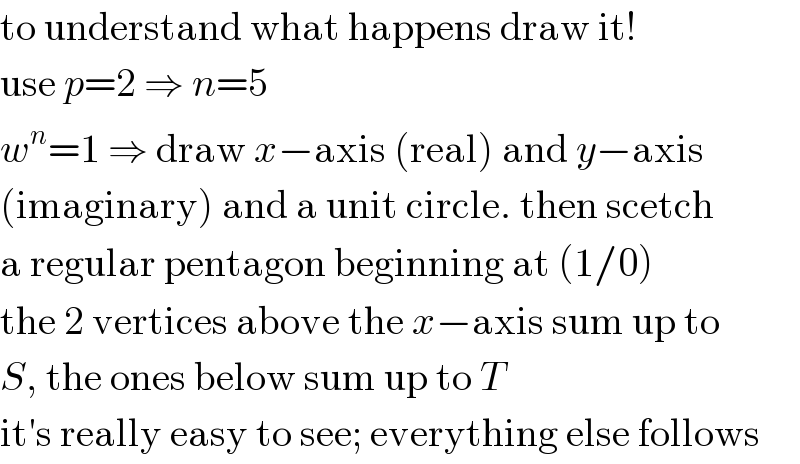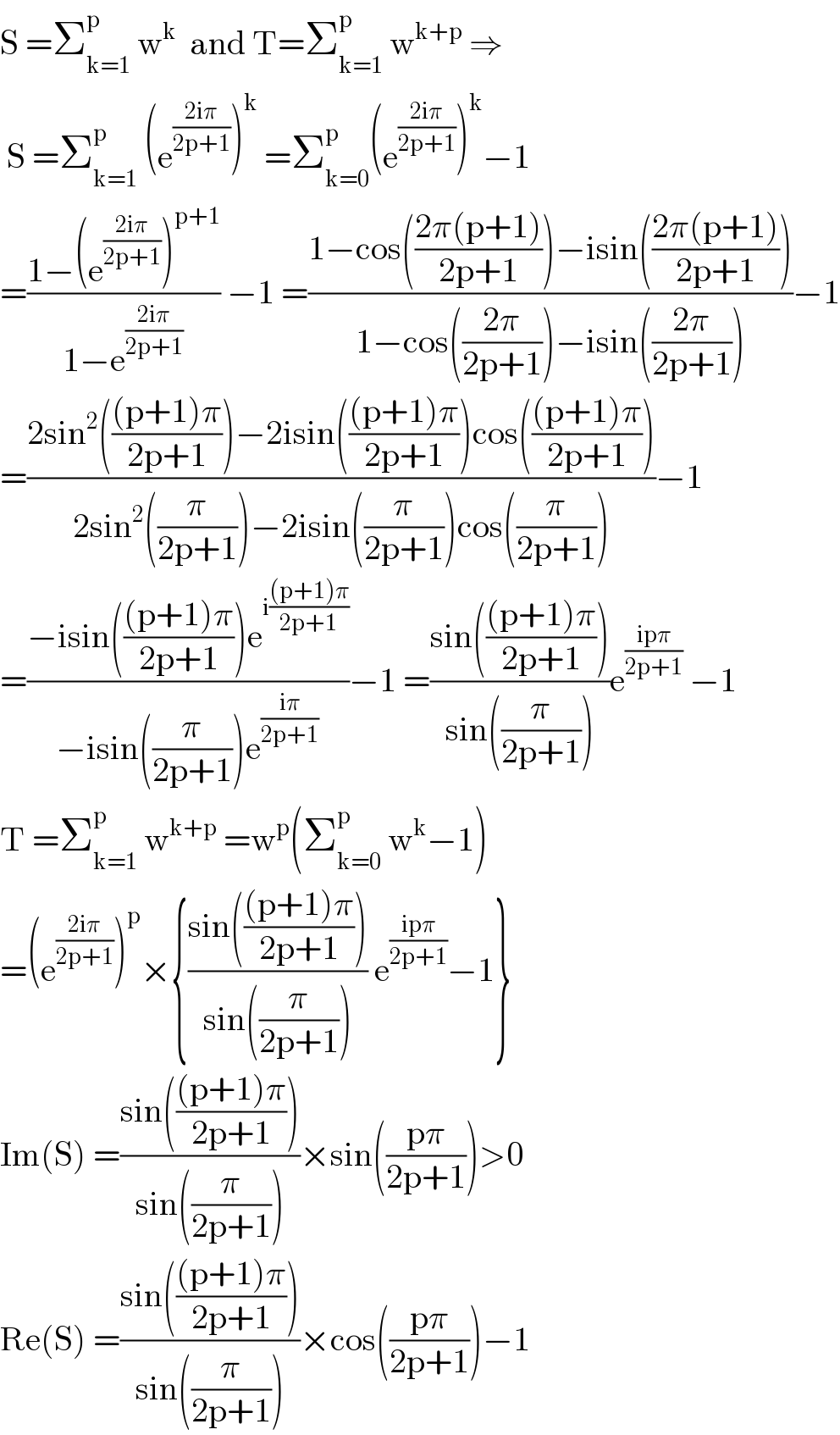Question Number 119136 by Hassen_Timol last updated on 22/Oct/20

Commented by MJS_new last updated on 22/Oct/20

$$\mathrm{to}\:\mathrm{understand}\:\mathrm{what}\:\mathrm{happens}\:\mathrm{draw}\:\mathrm{it}! \\ $$$$\mathrm{use}\:{p}=\mathrm{2}\:\Rightarrow\:{n}=\mathrm{5} \\ $$$${w}^{{n}} =\mathrm{1}\:\Rightarrow\:\mathrm{draw}\:{x}−\mathrm{axis}\:\left(\mathrm{real}\right)\:\mathrm{and}\:{y}−\mathrm{axis} \\ $$$$\left(\mathrm{imaginary}\right)\:\mathrm{and}\:\mathrm{a}\:\mathrm{unit}\:\mathrm{circle}.\:\mathrm{then}\:\mathrm{scetch} \\ $$$$\mathrm{a}\:\mathrm{regular}\:\mathrm{pentagon}\:\mathrm{beginning}\:\mathrm{at}\:\left(\mathrm{1}/\mathrm{0}\right) \\ $$$$\mathrm{the}\:\mathrm{2}\:\mathrm{vertices}\:\mathrm{above}\:\mathrm{the}\:{x}−\mathrm{axis}\:\mathrm{sum}\:\mathrm{up}\:\mathrm{to} \\ $$$${S},\:\mathrm{the}\:\mathrm{ones}\:\mathrm{below}\:\mathrm{sum}\:\mathrm{up}\:\mathrm{to}\:{T} \\ $$$$\mathrm{it}'\mathrm{s}\:\mathrm{really}\:\mathrm{easy}\:\mathrm{to}\:\mathrm{see};\:\mathrm{everything}\:\mathrm{else}\:\mathrm{follows} \\ $$
Commented by Hassen_Timol last updated on 22/Oct/20
Okay thank you very much
Answered by mathmax by abdo last updated on 22/Oct/20

$$\mathrm{S}\:=\sum_{\mathrm{k}=\mathrm{1}} ^{\mathrm{p}} \:\mathrm{w}^{\mathrm{k}} \:\:\mathrm{and}\:\mathrm{T}=\sum_{\mathrm{k}=\mathrm{1}} ^{\mathrm{p}} \:\mathrm{w}^{\mathrm{k}+\mathrm{p}} \:\Rightarrow \\ $$$$\:\mathrm{S}\:=\sum_{\mathrm{k}=\mathrm{1}} ^{\mathrm{p}} \:\left(\mathrm{e}^{\frac{\mathrm{2i}\pi}{\mathrm{2p}+\mathrm{1}}} \right)^{\mathrm{k}} \:=\sum_{\mathrm{k}=\mathrm{0}} ^{\mathrm{p}} \left(\mathrm{e}^{\frac{\mathrm{2i}\pi}{\mathrm{2p}+\mathrm{1}}} \right)^{\mathrm{k}} −\mathrm{1} \\ $$$$=\frac{\mathrm{1}−\left(\mathrm{e}^{\frac{\mathrm{2i}\pi}{\mathrm{2p}+\mathrm{1}}} \right)^{\mathrm{p}+\mathrm{1}} }{\mathrm{1}−\mathrm{e}^{\frac{\mathrm{2i}\pi}{\mathrm{2p}+\mathrm{1}}} }\:−\mathrm{1}\:=\frac{\mathrm{1}−\mathrm{cos}\left(\frac{\mathrm{2}\pi\left(\mathrm{p}+\mathrm{1}\right)}{\mathrm{2p}+\mathrm{1}}\right)−\mathrm{isin}\left(\frac{\mathrm{2}\pi\left(\mathrm{p}+\mathrm{1}\right)}{\mathrm{2p}+\mathrm{1}}\right)}{\mathrm{1}−\mathrm{cos}\left(\frac{\mathrm{2}\pi}{\mathrm{2p}+\mathrm{1}}\right)−\mathrm{isin}\left(\frac{\mathrm{2}\pi}{\mathrm{2p}+\mathrm{1}}\right)}−\mathrm{1} \\ $$$$=\frac{\mathrm{2sin}^{\mathrm{2}} \left(\frac{\left(\mathrm{p}+\mathrm{1}\right)\pi}{\mathrm{2p}+\mathrm{1}}\right)−\mathrm{2isin}\left(\frac{\left(\mathrm{p}+\mathrm{1}\right)\pi}{\mathrm{2p}+\mathrm{1}}\right)\mathrm{cos}\left(\frac{\left(\mathrm{p}+\mathrm{1}\right)\pi}{\mathrm{2p}+\mathrm{1}}\right)}{\mathrm{2sin}^{\mathrm{2}} \left(\frac{\pi}{\mathrm{2p}+\mathrm{1}}\right)−\mathrm{2isin}\left(\frac{\pi}{\mathrm{2p}+\mathrm{1}}\right)\mathrm{cos}\left(\frac{\pi}{\mathrm{2p}+\mathrm{1}}\right)}−\mathrm{1} \\ $$$$=\frac{−\mathrm{isin}\left(\frac{\left(\mathrm{p}+\mathrm{1}\right)\pi}{\mathrm{2p}+\mathrm{1}}\right)\mathrm{e}^{\mathrm{i}\frac{\left(\mathrm{p}+\mathrm{1}\right)\pi}{\mathrm{2p}+\mathrm{1}}} }{−\mathrm{isin}\left(\frac{\pi}{\mathrm{2p}+\mathrm{1}}\right)\mathrm{e}^{\frac{\mathrm{i}\pi}{\mathrm{2p}+\mathrm{1}}} }−\mathrm{1}\:=\frac{\mathrm{sin}\left(\frac{\left(\mathrm{p}+\mathrm{1}\right)\pi}{\mathrm{2p}+\mathrm{1}}\right)}{\mathrm{sin}\left(\frac{\pi}{\mathrm{2p}+\mathrm{1}}\right)}\mathrm{e}^{\frac{\mathrm{ip}\pi}{\mathrm{2p}+\mathrm{1}}} \:−\mathrm{1} \\ $$$$\mathrm{T}\:=\sum_{\mathrm{k}=\mathrm{1}} ^{\mathrm{p}} \:\mathrm{w}^{\mathrm{k}+\mathrm{p}} \:=\mathrm{w}^{\mathrm{p}} \left(\sum_{\mathrm{k}=\mathrm{0}} ^{\mathrm{p}} \:\mathrm{w}^{\mathrm{k}} −\mathrm{1}\right) \\ $$$$=\left(\mathrm{e}^{\frac{\mathrm{2i}\pi}{\mathrm{2p}+\mathrm{1}}} \right)^{\mathrm{p}} ×\left\{\frac{\mathrm{sin}\left(\frac{\left(\mathrm{p}+\mathrm{1}\right)\pi}{\mathrm{2p}+\mathrm{1}}\right)}{\mathrm{sin}\left(\frac{\pi}{\mathrm{2p}+\mathrm{1}}\right)}\:\mathrm{e}^{\frac{\mathrm{ip}\pi}{\mathrm{2p}+\mathrm{1}}} −\mathrm{1}\right\} \\ $$$$\mathrm{Im}\left(\mathrm{S}\right)\:=\frac{\mathrm{sin}\left(\frac{\left(\mathrm{p}+\mathrm{1}\right)\pi}{\mathrm{2p}+\mathrm{1}}\right)}{\mathrm{sin}\left(\frac{\pi}{\mathrm{2p}+\mathrm{1}}\right)}×\mathrm{sin}\left(\frac{\mathrm{p}\pi}{\mathrm{2p}+\mathrm{1}}\right)>\mathrm{0} \\ $$$$\mathrm{Re}\left(\mathrm{S}\right)\:=\frac{\mathrm{sin}\left(\frac{\left(\mathrm{p}+\mathrm{1}\right)\pi}{\mathrm{2p}+\mathrm{1}}\right)}{\mathrm{sin}\left(\frac{\pi}{\mathrm{2p}+\mathrm{1}}\right)}×\mathrm{cos}\left(\frac{\mathrm{p}\pi}{\mathrm{2p}+\mathrm{1}}\right)−\mathrm{1} \\ $$
Commented by Hassen_Timol last updated on 26/Oct/20
Thank you so much you save my entire life
